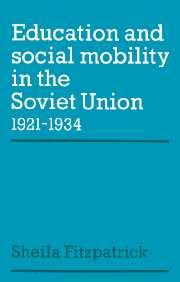6 - The ‘great turning-point’ of 1928–1929
Published online by Cambridge University Press: 11 November 2009
Summary
In March 1928, the State Prosecutor announced the discovery of a ‘counter-revolutionary economic conspiracy’ in the Shakhty region of the Donbass, in which engineers and other persons associated with the coal-mining industry had engaged in systematic disorganization of production at the behest of former mine owners and agents of foreign intelligence. This marked the ‘great turning-point’ (velikii perelom) in Soviet policy towards education and the intelligentsia. The Shakhty engineers were essentially on trial not as individuals but as representatives of a class: in the words of one of the accused, ‘all technical personnel brought up in the spirit of the old regime, with a very few exceptions, are tarred with the same brush and are equally unreliable for Soviet construction’.
The trial came at a time when the regime was launching the great industrialization drive of the First Five-Year Plan, and when engineers and technical personnel were therefore of increasing importance. The clear implication of the Shakhty trial was that Soviet construction required new technical personnel – a great many new technical personnel, whose loyalty could be relied on. The class on which the Soviet regime believed it could rely was the proletariat; and the campaign against the ‘bourgeois intelligentsia’ initiated by the Shakhty trial was to be accompanied by a massive recruitment of workers and Communists to higher education.
- Type
- Chapter
- Information
- Education and Social Mobility in the Soviet Union 1921–1934 , pp. 113 - 135Publisher: Cambridge University PressPrint publication year: 1979



